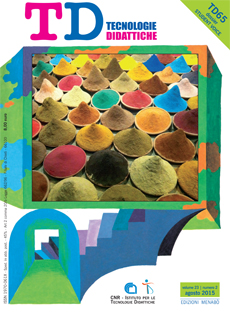The role of student communities in promoting Student Voice within university education
Main Article Content
Abstract
Article Details
Section
Authors who publish with this journal agree to the following terms:
- Authors retain copyright and grant the journal right of first publication with the work simultaneously licensed under a Creative Commons CC BY 4.0 Attribution 4.0 International License.
- Authors are able to enter into separate, additional contractual arrangements for the non-exclusive distribution of the journal's published version of the work (e.g., post it to an institutional repository or publish it in a book), with an acknowledgement of its initial publication in this journal.
- Authors are permitted and encouraged to post their work online (e.g., in institutional repositories or on their website) prior to and during the submission process, as it can lead to productive exchanges, as well as earlier and greater citation of published work (See The Effect of Open Access)
References
Angus, L. (2000). Educational leadership and the imperative of including student voices, student interest, and students’ lives in the mainstream. International Journal of Leadership in Education: Theory and Practice, 9(4), 369-379.
Blumler, J., & Katz, E. (1974). The Uses of Mass Communications. Beverly Hills, CA: Sage Publications.
Bragg, S. (2007). Consulting young people: A review of the literature. London, UK: Creative Partnerships.
Calvani, A., Fini, A., & Ranieri, M. (2010). La competenza digitale nella scuola. Metodi e strumenti per valutarla e svilupparla. Trento, IT: Erickson.
Clark, C. (1995). Flights of fancy, leaps of faith: Children’s myths in contemporary America. Chicago, IL: University of Chicago Press.
Coggi, C. (Ed.). (2005). Domande di qualità. Le istanze degli studenti universitari. Lecce, IT: Pensa Multimedia.
Cook-Sather, A. (2002a). Authorizing students’ perspectives: towards trust, dialogue, and charge in education. Educational Researcher, 31(4), 3-14.
Cook-Sather, A. (2002b). Re(in)forming the conversations: student position, power, and voice in teacher education. Radical Teacher, 64, 21-28.
Cook-Sather, A. (2009). Learning from the Student’s Perspective. A Sourcebook for Effective teaching. Boulder, CO: Paradigm.
Cook-Sather, A. (2013). Espressione, Presenza e Potere: “Student Voice” nella ricerca educative e in educazione. In V. Grion & A. Cook-Sather (Eds.), Student Voice. Prospettive internazionali e pratiche emergent in Italia (pp. 122-135). Milano, IT: Guerini.
Corrao, S. (2005). Il focus group. Milano, IT: Franco Angeli.
Creswell, J. W. (2009). Research design: Qualitative, quantitative, and mixed methods approaches. Thousand Oaks, CA: Sage Publications.
Creswell, J. W., Plano Clark, V. L., Gutmann, M., & Hanson, W. (2003). Advanced mixed methods designs. In A. Tashakkori & C. Teddlie (Eds.), Handbook of Mixed Methods in Social & Behavioral Research (pp. 209-240).Thousand Oaks, CA: Sage Publications.
Fielding, M. (2012). Beyond Student Voice: Patterns of Partnership and the Demands of Deep Democracy. Revista de Educación, 359, 45-65.
Fullan, M. (1991). The New Meaning of Educational Change. New York, NY: Teachers College Press.
Garlick, S. (2008). Can we hear the student voice?. Management in Education British Educational Leadership, 22(3), 15-18.
Garavaglia, A. (2006). Ambienti per l’apprendimento in rete. Gli spazi dell’elearning. Azzano San Paolo, IT: Edizioni Junior.
Gemma, C., Agrati, L., & Damato, F. (2014). Studenti e/o tirocinanti. Il Tirocinio dal punto di vista del banco. In C. Laneve & F. Pascolini (Eds.), Nella Terra di Mezzo. Una ricerca sui Supervisori del Tirocinio (pp. 251-291). Brescia, IT: Editrice La Scuola.
Ghislandi, P., & Raffaghelli, J. (2013). La voce degli studenti per la qualità dell’elearning nella formazione universitaria: un approccio partecipativo. In V. Grion & A. Cook-Sather (Eds.), Student Voice. Prospettive internazionali e pratiche emergenti in Italia (pp. 273-286). Milano, IT: Guerini.
Grion, V., & Varisco, B. M. (2007). Online Collaboration for Building a Teacher Professional Identity. PsychNology Journal, 5, 3, 271-284.
Gunther, H., & Thomson, P. (2007). Learning about student voice. Support for Learning, 22(4), 181-188.
Hudson-Ross, S., Cleary, L., & Casey, M. (1993). Children’s voices: Children talk about literacy. Portsmouth, NH: Heineman.
Jakobson, R. (1978). La linguistica e le scienze dell’uomo: sei lezioni sul suono e sul senso. Milano, IT: Il Saggiatore.
Knowles, M. (1997). Quando l’adulto impara. Pedagogia e andragogia. Milano, IT: Franco Angeli.
Nigris, E. (2006). Provare per pensare: costruire competenze didattiche attraverso l’esperienza. In O. Albanese (Ed), Disabilità, integrazione e formazione degli insegnanti (pp. 271-293). Azzano San Paolo, IT: Edizioni Junior.
Rheingold, H. (2008). Using Participatory Media and Public Voice to Encourage Civic Engagement. In L. Bennet (Ed.), Civic Life Online: Learning How Digital Media Can Engage Youth (pp. 97-118). Cambridge, MA: The MIT Press.
Rogers, C. R. (1997). Terapia centrata sul cliente. Firenze, IT: La Nuova Italia.
Rudduck, J., & Flutter, J. (2004). How to improve your school: giving pupils voice. London, UK: Continuum.
Rudduck, J., & McIntyre, D. (2007). Improving Learning Through Consulting Pupils. Abingdon, UK: Routledge.
Semeraro, R. (Ed.) (2006). La valutazione della didattica universitaria: docenti e studenti protagonisti in un percorso di ricerca. Milano, IT: Franco Angeli.
Zuccoli, F. (2013). La pratica della discussione, una metodologia indispensabile per attivare la voce degli studenti. In V. Grion, & A. Cook-Sather (Eds.), Student Voice. Prospettive internazionali e pratiche emergenti in Italia (pp. 212-231). Milano, IT: Guerini.

